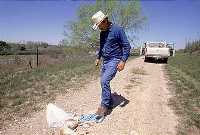Vehicle barriers erected across southwestern United States desert to thwart smugglers
Two hundred miles (320 kilometers) of vehicle barriers are being erected across the southwestern United States desert to thwart smugglers trying to bring illegal immigrants or drugs into the country.

Smugglers commonly drive people and marijuana over the Mexican border, using roads that have been illegally cut across remote sections of the vast desert.
Authorities concede the vehicle barriers will not deter people on foot, whether illegal immigrants or backpacking drug runners. But the obstacles might slow them down and make them easier to catch as they hike across miles of rocky, hilly terrain.
The building of the barriers is being overseen by a combination of federal agencies at a total cost of tens of millions of dollars.
The obstructions include bollards, or concrete-filled steel poles poking out of the ground at staggered heights; railroad rails welded horizontally onto concrete-reinforced steel posts; and X-shaped rail barricades weighing up to 1,400 pounds (635 kilograms).
The barriers are in addition to the border fences meant to stop pedestrians in more populated areas such as the Arizona communities of Douglas and Nogales.
The lines of barriers have been going up for years as authorities have looked for ways to stop the influx of illegal immigrants into the four southern border states, which also include Texas, New Mexico and California. Arizona's 377-mile (607-kilometer) border is the busiest segment for illegal entries.
Already, about 80 miles (128 kilometers) of vehicle barriers are in place along the U.S.-Mexico border. Authorities look to have a total of 200 miles (320 kilometers) of barriers in place, mostly in Arizona and New Mexico, by the end of next year.
At Arizona's Organ Pipe Cactus National Monument, the barriers put up along 29 miles (47 kilometers) of the park's southern boundary at a cost of $14 million (EUR10.3 million) were a response to the 2002 killing of a park ranger by criminals fleeing Mexican authorities.
Chief Ranger Fred Patton said the fortifications, completed last July, have been effective so far at the 515-square-mile (1,334-square-kilometer) park, which is crisscrossed by hundreds of illegal roads.
"It's eliminated the vast majority of the vehicular smuggling that was taking place before," Patton said. "We still get some, but comparatively, it's not anywhere close to what it was."
Smugglers and other criminals can still circle around the Organ Pipe barriers to the east and west and drive in through other isolated stretches of the border.
But authorities are optimistic about what they will be able to do to stop it once more barriers are erected across the landscape.
No one suggests that they are an ultimate solution, however.
Patton said smugglers can drive up to the barrier from the south and unload their contraband human or otherwise into other vehicles on the north side of the barrier.
Others say a preoccupation with physical structures overlooks one big source of the problem.
Benjamin Johnson, director of the Washington-based Immigration Policy Center, which advocates comprehensive immigration reform, said half the country's illegal immigrants entered legally and then overstayed their visas.
"If we hermetically sealed the southern border, you're still only dealing with half of the undocumented immigration problem," he said. "Given the amount of money that it would take to secure against that traffic, it seems to be a waste of resources."
Subscribe to Pravda.Ru Telegram channel, Facebook, RSS!


